Warts in dogs: My experience with treatment
After researching warts in dogs, I discovered that my pet had viral warts. Fortunately, with proper treatment and patience, the warts disappeared completely. I recommend consulting a veterinarian for the best treatment for warts in dogs.
Warts in dogs
Warts in dogs are a common problem that can affect the health and well-being of your pet. Read on to learn how to identify, treat, and prevent warts in dogs.
Causes of warts in dogs
Warts in dogs can be caused by a variety of factors, including:
- Canine papillomavirus: This virus is one of the main causes of warts in dogs. It is transmitted through direct contact with infected dogs and can affect dogs of all ages.
- Skin trauma: Warts can also develop as a result of injuries to the skin, such as scratches or bites.
- Weakened immune system: Dogs with a weakened immune system are more likely to develop warts, as their body has a difficult time fighting off viral infections.
- Genetic factors: Some dog breeds may be genetically more susceptible to developing warts than others.
It is important to identify the underlying cause of warts in dogs so that the best treatment approach can be determined.
Symptoms of warts in dogs
Warts in dogs can present in different ways, and it is important to pay attention to the following symptoms:
Bumps on the skin
Warts in dogs usually manifest as small bumps on the skin, which can vary in size and shape. These bumps can appear anywhere on the dog’s body, including the head, neck, paws, and abdomen.
Changes in skin texture
Warts in dogs can cause changes in the texture of the skin, making it rough or scaly around the affected area. These changes may be evident by touch or with the naked eye.
Itching or discomfort
Dogs with warts may experience itching or discomfort in the affected area. The dog may lick, bite, or scratch the wart frequently, which can worsen the condition.
Bleeding or discharge
In some cases, warts on dogs may bleed or produce discharge. This may be indicative that the wart is infected or irritated, and requires immediate veterinary attention.
It is important to watch your pet closely for these symptoms, as warts in dogs can cause discomfort and affect their quality of life. If you notice any of these symptoms in your dog, it is advisable to consult a veterinarian for proper diagnosis and treatment of warts in dogs.
Diagnosis of warts in dogs
To determine if your dog has warts, it is important to carry out an accurate diagnosis. Here are some ways veterinarians can diagnose warts in dogs:
Physical exam
A veterinarian will perform a detailed physical examination to identify any bumps or changes in your dog’s skin. This may include observing the location, size, and appearance of the warts.
Wart biopsy
In some cases, a biopsy of the wart may be done to analyze it in a laboratory to determine if it is benign or malignant. This can help guide proper treatment for warts in dogs.
Lab tests
In addition to the biopsy, laboratory tests may be performed to detect the presence of viruses or infections that may be related to warts in dogs. These tests can help identify the underlying cause of warts and guide treatment.
With an accurate diagnosis, you will be able to take the necessary steps to treat warts in dogs effectively and prevent their spread to other animals or even humans. Remember that consultation with a veterinarian is essential to ensure the health and well-being of your pet.
Treatment of warts in dogs
Warts in dogs can be treated in several ways, depending on the type and severity of the condition. Some treatment options include:
Cryotherapy
This method involves freezing the warts with liquid nitrogen to remove them. It is a common treatment for viral warts in dogs.
Surgery
In more severe cases, surgical wart removal may be necessary, especially for genital warts in dogs.
Topical medications
Some topical medications, such as creams or solutions, may be prescribed by a veterinarian to apply directly to warts in dogs.
Natural therapies
Some natural remedies, such as apple cider vinegar or aloe vera, have been used to treat warts in dogs naturally and safely.
It is important to consult a veterinarian before starting any treatment for warts in dogs, as the appropriate approach will depend on the pet’s specific condition.
Prevention of warts in dogs
Preventing warts in dogs is essential to keep our pets healthy and free of these annoying bumps. Some steps we can take include:
Vaccination
Vaccination against canine papillomavirus is an effective way to prevent the appearance of warts in dogs. Consult your veterinarian about the appropriate vaccination schedule for your pet.
Maintain good hygiene
Regular care of your dog’s skin and coat can help prevent the appearance of warts. Bathing him regularly and keeping him clean and dry can reduce the risk of viral and skin infections.
Avoid contact with infected dogs
Prevent your dog from having contact with other animals that have warts. This can reduce the risk of catching and spreading the infection.
Strengthen the immune system
A balanced diet, regular exercise, and regular visits to the vet can help strengthen your dog’s immune system, which in turn can reduce the likelihood of developing warts.
By following these preventive measures, you can help protect your pet from dog warts and keep him healthy and happy.
Warts in dogs: are they contagious to humans?
Warts in dogs, whether viral or non-viral, can raise the question of whether they are contagious to humans. The risks of contagion, prevention measures and the importance of consulting with a veterinarian are discussed below.
Contagion risks
Warts in dogs, especially viral ones caused by the canine papillomavirus, can be contagious to other dogs through direct contact. However, the risk of infection for humans is low, but cannot be completely ruled out.
Preventive measures
To prevent the spread of dog warts to humans, it is important to follow these measures:
- Maintain good hygiene when handling warts on dogs, washing your hands after contact.
- Avoid direct contact with warts in dogs, especially if there is an open wound on the skin.
- Consult a veterinarian for specific guidance on preventing infection.
Consult with a veterinarian
In the presence of warts in dogs, it is essential to consult with a veterinarian to obtain an accurate diagnosis and an appropriate treatment plan. In addition, the veterinarian will be able to provide guidance on measures to prevent contagion to humans.
When to see a veterinarian for warts in dogs?
Warts in dogs can be a nuisance for your pet, but when should you consult a veterinarian? Here are some warning signs that indicate it’s time to seek professional help:
Persistence of warts
If your dog’s warts do not go away or get worse over time, it is important to have them examined by a veterinarian to rule out any complications.
Changes in the dog’s behavior
If you notice that your dog is more restless, depressed, or showing signs of discomfort, the warts could be causing him discomfort and the situation needs to be evaluated by a veterinarian.
Pain or discomfort for the dog
If you notice that your dog exhibits pain when touching the warts or shows signs of discomfort when walking or moving, it is crucial that a veterinarian determine the best course of action to relieve his discomfort.
Remember that the health and well-being of your pet is a priority, so do not hesitate to seek professional help if you have any concerns related to warts in dogs.
Home remedies for warts in dogs
If you are looking for natural options to treat warts in dogs, there are several home remedies that could help alleviate this problem. Although it is important to consult a veterinarian before trying any at-home treatment, these remedies can be a complementary option to professional care.
Apple vinager
Apple cider vinegar has traditionally been used to treat warts in humans, and some pet owners have found that it can be effective in dogs as well. Applying a small amount of apple cider vinegar to the wart several times a day may help reduce its size and discomfort.
aloe vera
Aloe vera is known for its healing and anti-inflammatory properties. Applying aloe vera gel directly to the wart in dogs can help relieve itching and reduce inflammation. However, it is important to ensure that the dog does not lick the gel, as aloe vera is not safe for consumption.
tea tree oil
Tea tree oil has antimicrobial and anti-inflammatory properties that could help combat warts in dogs. Diluting a few drops of tea tree oil in water and applying it to the wart with a cotton ball can be a natural way to treat this skin problem.
Balance diet
A balanced, nutrient-rich diet is essential for maintaining the health of your dog’s skin and immune system. Feeding your pet high-quality foods and appropriate supplements can help strengthen their immune system and reduce the likelihood of developing warts.
In summary, home remedies for warts in dogs can be a complementary option to conventional veterinary treatment. However, it is crucial to consult a professional before trying any remedy at home, and to keep an eye out for any changes in the condition of your pet’s wart.
Personal experiences with warts in dogs
Warts on dogs are a common concern for many pet owners. Here are some personal experiences and tips from people who have dealt with warts in dogs.
Testimonials from pet owners
– “My dog developed warts after playing with other dogs at the park. It was a difficult process, but with proper treatment, the warts disappeared.”
– “My dog had genital warts, which worried me a lot. Thanks to the guidance of my veterinarian, we were able to treat them successfully.”
– “I never thought that warts in dogs were so contagious. After my dog developed them, I had to take extreme measures to prevent them from spreading to other dogs in the house.”
Tips and recommendations
– Stay calm and seek professional guidance if you notice warts on your dog.
– Do not try to treat warts on your own without consulting a veterinarian.
– Be sure to follow prevention guidelines to prevent warts from spreading to other dogs in your home.
Success stories in the treatment of warts in dogs
– “After following the treatment recommended by my veterinarian, my dog’s warts disappeared completely. It is important to be patient and follow the professional’s instructions.”
– “Thanks to vaccination and a comprehensive approach to strengthening my dog’s immune system, we managed to prevent the recurrence of warts.” ;
These personal experiences demonstrate the importance of being informed about warts in dogs and seeking professional help when necessary. Prevention, proper treatment, and patience are key to managing warts in dogs effectively.










